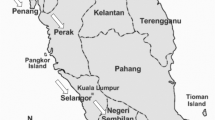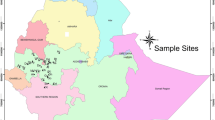Abstract
Casuarina is a widely cultivated plantation tree species in coastal India, primarily due to its fast growth, high productivity and suitable for pulp and paper production. However, genetic studies of Casuarina have been hindered by lack of genomic resources and genetic markers. Knowledge of the genetic diversity and population structure of Casuarina germplasms will provide the basis for utilizing and improving resource in the breeding program. Keeping this in view, in the present study, we have identified a total of 11,503 simple sequence repeat (SSR) makers from 86,415 expressed sequence tags (ESTs) of Casuarina equisetifolia and C. junghuhniana after redundancy elimination. Dinucleotide repeats were the most abundant accounting for 72.5 % of all microsatellites, followed by trimer (23.4 %), hexamer (1.7 %), tetramer (1.5 %), and very few pentamer (0.6 %) repeats. Of these, 50 markers were used to estimate genetic diversity and population structure among 96 accessions of C. cunninghamiana and C. junghuhniana. EST-SSR markers revealed high level of polymorphism, detecting a total of 829 alleles with an average of 17 alleles per locus. Polymorphic information content (PIC) values ranged from 0.32 to 0.93, with an average of 0.78 per locus. The average observed (H o ) and expected heterozygosity (H e ) obtained was high and fairly similar in C. cunninghamiana and C. junghuhniana, thereby suggesting highly heterogeneous nature of Casuarina. Population structure using a Bayesian model-based clustering approach identified clear delineation between C. cunninghamiana and C junghuhniana. Further, these markers were also evaluated in four species of Casuarina confirming high rate of cross-species transferability. The results of this study can provide valuable insights for genetic and genomic research in Casuarina.



Similar content being viewed by others
References
Agarwal M, Shrivastava N, Padh H (2008) Advances in molecular marker techniques and their applications in plant science. Plant Cell Rep 27:617–613
Aggarwal RK, Hendre PS, Varshney R, Bhat PR, Krishnakumar V, Singh L (2007) Identification, characterization and utilization of EST-derived genic microsatellite markers for genome analyses of coffee and related species. Theor Appl Genet 114:359–372
Buehler D, Graf R, Holderegger R, Gugerli F (2011) Using the 454 pyrosequencing-based technique in the development of nuclear microsatellite loci in the alpine plant Arabis alpina (Brassicaceae). Am J Bot 98:e103–e105
Ceresini PC, Petrarolha Silva CLS, Missio RF, Souza EC, Fischer CN, Guillherme IR, Gregorio I, da Silva EHT, Cicarelli RMB, da Silva MTA (2005) Satellypus: analysis and database of microsatellites from ESTs of Eucalyptus. Gen Mol Biol 28:589–600
Chezhian P, Yasodha R, Ghosh M (2009) Genetic diversity analysis in Casuarina and Allocasuarina species using ISSR markers. Madras Agric J 96(1–6):32–39
Daniel D, Christian S (2003) Microsatellite analyser (MSA): a platform independent analysis tool for large microsatellite data sets. Mol Ecol Notes 3:167–169
El-Lakany M (1996) A brief account of Casuarina research: past achievements and future trends. In: Proceedings of the 3rd international Casuarina workshop, CSIRO, Australia, pp 12–16.
Ellis J, Burke J (2007) EST-SSRs as a resource for population genetic analyses. Heredity 99(2):125–132
Evanno G, Regnaut S, Goudet J (2005) Detecting the number of clusters of individuals using the software STRUCTURE: a simulation study. Mol Ecol 14:2611–2620
Felsenstein J (1993) PHYLIP (Phylogeny Inference Package) version 3.5c. Distributed by the author. Department of Genetics, University of Washington, Seattle
Friedt WR, Snowdon F, Ordon AJ (2007) Plant breeding: assessment of genetic diversity in crop plants and its exploitation in breeding. Prog Bot 68:151–178
Fusari CM, Rienzo JA, Troglia C (2012) Association mapping in sunflower for Sclerotinia head rot resistance. BMC Plant Biol 12:93
Gong L, Stift G, Kofler R, Pachner M, Lelley T (2008) Microsatellites for the genus Cucurbita and an SSR-based genetic linkage map of Cucurbita pepo L. Theor Appl Genet 117:37–48
Gupta P, Varshney R (2000) The development and use of microsatellite markers for genetic analysis and plant breeding with emphasis on bread wheat. Euphytica 113:163–185
Gupta P, Rustgi S, Sharma S, Singh R, Kumar N, Balyan H (2003) Transferable EST-SSR markers for the study of polymorphism and genetic diversity in bread wheat. Mol Genet Genomics 270(4):315–323
Hamrick JL, Godt MJW (1996) Effects of life history traits on genetic diversity in plant species. Philos Trans R Soc Lond B Biol Sci 351:1291–1298
Ho KY, Lee SC (2011) ISSR-based genetic diversity of Casuarina spp. In coastal windbreaks of Taiwan. Afr J Agric Res 6(25):5664–5671
Ho KY, Yang JC, Hsiao JY (2002) An assessment of genetic diversity and documentation of hybridization of Casuarina grown in Taiwan using RAPD markers. Int J Plant Sci 163:831–836
Jurka J, Pethiyagoda C (1995) Simple repetitive DNA sequences from primates: compilation and analysis. J Mol Evol 40:120–126
Kalia RK, Rai MK, Kalia S, Singh R, Dhawan AK (2011) Microsatellite markers: an overview of the recent progress in plants. Euphytica 117:309–334
Kamalakannan R, Barthwal S, Chezhian P, Balasaravanan T, Yasodha R, Gurumurthi K, Ghosh M (2006) Morphological and molecular diversity among Casuarina and Allocasuarina species. Biotechnology 5:301–307
Kudapa H, Azam S, Sharpe AG, Taran B, Li R, Deonovic B, Varshney RK (2014) Comprehensive transcriptome assembly of chickpea Cicer arietinum L. Using Sanger and next generation sequencing platforms: development and applications. PLoS One 9(1):e86039
Lewis PO and Zaykin D (2002) GDA 1.1. The University of Connecticut.
Mahalakshmi V, Aparana P, Ramadevi S, Ortiz R (2002) Genomic sequence derived simple sequence repeat markers. Case study with Medicago spp. Electron J Biotechnol 5:233–242
Marshall TC, Late JS, Kruuk LEB, Pemberton JM (1998) Statistical confidence for likelihood-based paternity inference in natural populations. Mol Ecol 7:639–655
Ndoye AL, Sadio O, Diouf D (2011) Genetic variation of Casuarina equisetifolia subsp equisetifolia and C. equisetifolia subsp incana populations on the northern coast of Senegal. Genet Mol Res 10(1):36–46
Nei M, Li WH (1979) Mathematical model for studying genetic variation in terms of restriction endonucleases. Proc Natl Acad Sci U S A 76:5269–5273
Nesbitt KA, Potts BM, Vaillancourt RE, West AK, Reid JB (1995) Partitioning and distribution of RAPD variation in a forest tree species, Eucalyptus globulus (Myrtaceae). Heredity 74:628–637
Newton AC, Allnutt TR, Gillies ACM, Lowe AJ, Ennos RA (1999) Molecular phylogeography, intraspecific variation and the conservation of tree species. Trends Ecol Evol 14:140–145
Nybom H (2004) Comparison of different nuclear DNA markers for estimating intraspecific genetic diversity in plants. Mol Ecol 13:1143–1155
Orwa C, Mutua A, Kindt R, Jamnadass R, Anthony S (2009) Agroforestree database: a tree reference and selection guide version 4.0. http://www.worldagroforestry.org/af/treedb/. Accessed 10 June 2012
Ott J (1992) Strategies for characterizing highly polymorphic markers in human gene mapping. Am J Hum Genet 51:238–290
Page RDM (1996) Tree view: an application to display phylogenetic trees on personal computers. Comput Appl Biosci 12(4):357–358
Parida SK, Kullan ARK, Dalal V, Singh NK, Mohapatra T (2006) Unigene derived microsatellite markers for the cereal genomes. Theor Appl Genet 112:808–817
Peakall R, Smouse PE (2012) GenAlEx 6.5: genetic analysis in Excel. Population genetic software for teaching and research—an update. Bioinformatics 28:2537–2539
Pinyopusarerk K, House APN (1993) Casuarina: an annotated bibliography of Casuarina equisetifolia, C. junghuhniana and C. oligodon. International Center for Research in Agroforestry, Nairobi
Poland JA, Rife TW (2012) Genotyping-by-sequencing for plant breeding and genetics. Plant Genome 5:92–102
Pritchard JK, Stephens M, Donnelly P (2000) Inference of population structure using multilocus genotype data. Genetics 155:945–959
Ramakrishnan M, Shanthi A, Ceasar SA, Duraipandiyan V, Ignacimuthu S (2013) Genetic diversity, origination and extinction analysis in Casuarina equisetifolia using RAPD markers. Asian J Plant Sci 3(2):81–87
Rungis D, Berube Y, Zhang J, Ralph S, Ritland CE, Ellis BE, Douglas C, Bohlmann J, Ritland K (2004) Robust simple sequence repeat markers for spruce (Picea spp.) from expressed sequence tags. Theor Appl Genet 109(6):1283–1294
Saha MC, Mian MAR, Eujayl I, Zwonitzer JC, Wang L, May GD (2004) Tall fescue EST-SSR markers with transferability across several grass species. Theor Appl Genet 109(4):783–791
Schneider S, Roessli D, Excoffier L (2000) Arlequin: a software for population genetic data. Genetics and Biometry Laboratory, University of Geneva, Switzerland
Shepherd M, Jones ME (2005) Molecular markers in tree improvement: characterisation and use in Eucalyptus. In: Lorz H, Wenzel G (eds) Molecular marker systems in plant breeding and crop improvement. Springer, Heidelberg, pp 399–409
Sumathi M, Yasodha R (2014) Microsatellite resources of Eucalyptus: current status and future perspectives. Bot Stud 55:73
Thiel T, Michalek W, Varshney RK, Graner A (2003) Exploiting EST databases for the development and characterization of gene-derived SSR-markers in barley (Hordeum vulgare L.). Theor Appl Genet 106:411–422
Toth G, Gaspari Z, Jurka J (2000) Microsatellites in different eukaryotic genomes: survey and analysis. Genome Res 10:967–981
Trong TQ, van Bers N, Crooijmans R, Dibbits B, Komen H (2013) A comparison of microsatellites and SNPs in parental assignment in the GIFT strain of Nile tilapia (Oreochromis niloticus): the power of exclusion. Aquaculture 388–391:14–23
U.S. National Research Council (1984) Casuarinas: nitrogen-fixing trees for adverse sites. National Academy Press, Washington
Varshney RK, Thiel T, Stein N, Langridge P, Graner A (2002) In silico analysis on frequency and distribution of microsatellites in ESTs of some cereal species. Cell Mol Biol Lett 7(2A):537–546
Varshney RK, Graner A, Sorrells ME (2005) Genic microsatellite markers in plants: features and applications. Trends Biotechnol 23(1):48–55
Xiao Y, Cai D, Yang W, Ye W, Younas M, Wu J, Liu K (2012) Genetic structure and linkage disequilibrium pattern of a rapeseed (Brassica napus L.) association mapping panel revealed by microsatellites. Theor Appl Genet 125:437–447
Yang X, Xu Y, Shah T, Li H, Han Z, Li J, Yan J (2011) Comparison of SSRs and SNPs in assessment of genetic relatedness in maize. Genetica 139:1045–1054
Yasodha R, Kathirvel M, Sumathi R, Gurumurthi K, Sunil A, Nagaraju J (2004) Genetic analyses of casuarinas using ISSR and FISSR markers. Genetica 122:161–172
Yasodha R, Sumathi R, Chezhian P, Kavitha S, Ghosh M (2008) Eucalyptus microsatellites mined in silico: survey and evaluation. J Genet 87(1):21–25
Yasodha R, Sumathi R, Ghosh M, Gurumurthi K (2009) Identification of simple sequence repeats in Casuarina equisetifolia. IUP J Genet Evol 2(1):46–55
Yeh FC, Chong DKX, Yang RC (1995) RAPD variation within and among natural populations of trembling aspen (Populus tremuloides Michx.) from Alberta. J Hered 86:454–460
Yu JK, Dake TM, Singh S, Benscher D, Li W, Gill B, Sorrells ME (2004) Development and mapping of EST-derived simple sequence repeat markers for hexaploid wheat. Genome 47(5):805–818
Zhangying W, Jun L, Zhongxia L, Lifei H, Boping F, Yujun L, Jingyi C, Xiongjian Z (2011) Characterization and development of EST-derived SSR markers in cultivated sweet potato (Ipomoea batatas). BMC Plant Biol 11(1):139
Acknowledgments
The author thanks Dr. Mohan Varghese for his guidance and Dr. Ramasamy Annadurai for his valuable comments on the manuscript and Dr. Kamalakannan Rathinam for facilitating assembly of plant materials. The research work was supported by Life Science and Technology Centre, ITC Ltd, Bangalore, India, under the framework of developing adaptable Casuarina in in-land conditions.
Data archiving statement
EST sequences used in this study were deposited into NCBI (Accession number: PRJNA294034).
Author information
Authors and Affiliations
Corresponding author
Additional information
Communicated by G. G. Vendramin
Rights and permissions
About this article
Cite this article
Kullan, A.R.K., Kulkarni, A.V., Kumar, R.S. et al. Development of microsatellite markers and their use in genetic diversity and population structure analysis in Casuarina . Tree Genetics & Genomes 12, 49 (2016). https://doi.org/10.1007/s11295-016-1009-8
Received:
Revised:
Accepted:
Published:
DOI: https://doi.org/10.1007/s11295-016-1009-8




